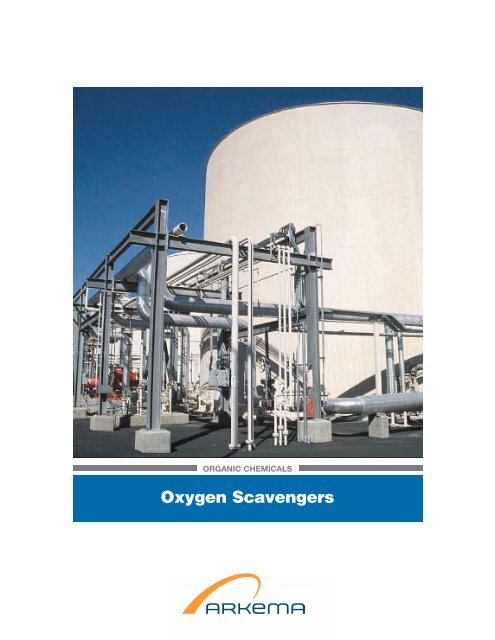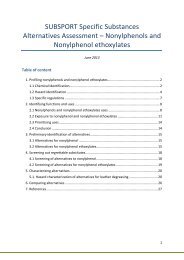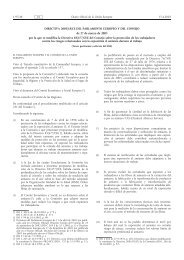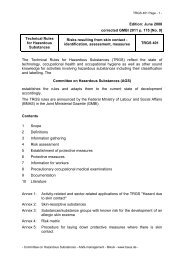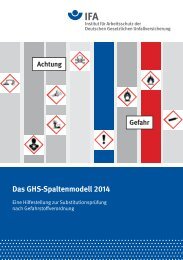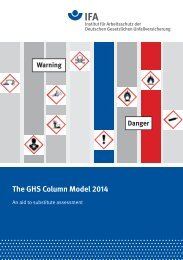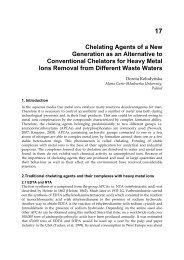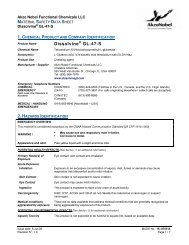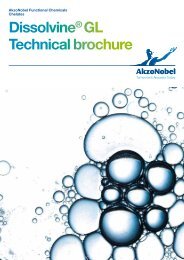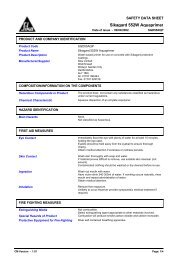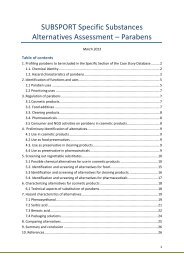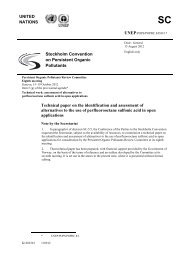Oxygen Scavengers - Subsport
Oxygen Scavengers - Subsport
Oxygen Scavengers - Subsport
You also want an ePaper? Increase the reach of your titles
YUMPU automatically turns print PDFs into web optimized ePapers that Google loves.
ORGANIC CHEMICALS<strong>Oxygen</strong> <strong>Scavengers</strong>
SELECTION GUIDE FOR OXYGEN SCAVENGERS<strong>Oxygen</strong> <strong>Scavengers</strong>Corrosion by oxygen in the boiler can be controlled by theaddition of an “oxygen scavenger” to the preboiler sectionof the steam generating system. It is generally fed, alongwith other treatment chemicals, as an aqueous solution tothe feedwater either just upstream or, preferably, just downstreamof the deaerator, although it is sometimes addedinto the return lines to scavenge oxygen in the condensate.The most widely used materials in this application are sodiumsulfite (Na 2 SO 3 ) and hydrazine (N 2 H 4 ), both of whichare usually sold as catalyzed systems to enhance reactivitywith oxygen at lower temperatures and pressures. Quinonesand cobalt salts are typically used as catalysts. Sulfite isthe least expensive and most active (when catalyzed) forlower and medium pressure boilers [up to 600 psig (42 barabs)]. In its reaction with oxygen, sodium sulfite producessodium sulfite produces sodium sulfate, which contributessolids to the circulating boiler system:2 Na 2 SO 3 + O 2 → 2 Na 2 SO 4Thus, in high pressure and supercritical boilers, where anysolids constitute a severe problem, sulfite cannot be used.The theoretical dosage of sodium sulfite, or the number ofparts of Na 2 SO 3 required to consume 1 part of O 2 , can becalculated based on its reaction with oxygen describedabove:2(126 g/mole Na 2 SO 3 ) = 7.88 theoretical32 g/mole O 2Therefore, about 8 parts of Na 2 SO 3 are fed to the boiler to consumeeach part of oxygen. Typically, residual concentrationsof sulfite of up to 20 ppm are maintained in the boiler.Sulfite also breaks down at pressures as low as 600 psig(41 bar abs) resulting in the formation of sulfur dioxide orhydrogen sulfide, by either of two routes:Na 2 SO 3 + H 2 O → SO 2 + 2 NaOH4 Na 2 SO 3 + 2 H 2 O → H 2 S + 2 NaOH + 3 Na 2 SO 4Both are corrosive gases which leave the boiler with steam,resulting in low pH steam and condensate and potentialattack throughout the system.Sulfite is an effective oxygen scavenger, but it is nonvolatileand does not leave the boiler with the steam, thusproviding no protection in the condensate system. Sulfitealso does not reduce hematite to magnetite and is ineffectivein repassivating boilers with existing rust.The oxygen scavengers used in the higher pressure boilers,and the ones with which diethylhydroxylamine (DEHA) competesmost directly are hydrazine and catalyzed hydrazine.Hydrazine does not produce corrosive gases at high temperaturesand pressures, and in application, reacts withoxygen to form nitrogen and water:N 2 H 4 + O 2 → 2 H 2 O + N 2In calculating the theoretical requirement of hydrazine forscavenging oxygen, a value of 1 part per part oxygen isobtained:32 g/mole hydrazine = 132 g/mole O 2In operation, a 100% excess of hydrazine is used. Boilerresiduals of 1 ppm hydrazine are typically maintained.Hydrazine does not contribute solids to the system, soboiler blowdown, or the mechanical removal of solids fromthe after-boiler section as sludge, is reduced. It also promotesthe formation of the protective magnetite film on the boilertubes and drum, and converts red iron dust (hematite) tomagnetite. It is because of these passivation effects that anexcess of scavenger to oxygen is required when changinga boiler system form a non-passivating scavenger to onewhich passivates.Hydrazine is not without limitations. It is not considered“volatile”, so it does not leave the boiler with the steam toscavenge oxygen and passivate metal throughout thesystem. In boilers operating above 400˚F (205˚C), it candegrade to ammonia and volatilize with steam, and, in thepresence of oxygen, attack metals containing copper:2 N 2 H 4 → 2 NH 3 + N 2 + H 2Finally, and most importantly of late, is the inclusion ofhydrazine on the OSHA and NIOSH lists as a suspect carcinogen.Papers and sales literature presenting laboratoryand field data on “hydrazine alternatives” abound, andinclude those listed in Tables 1 and 2. Each claims to be asafe and effective material for boiler protection throughoxygen scavenging, but the levels required and optimumconditions for use vary.Carbohydrazide is a volatile oxygen scavenger, contributesno solids to the system, reacts readily with oxygen at lowtemperatures and pressures, and passivates the metal ofthe boiler system. Carbohydrazide can (and does) breakdown to hydrazine above temperatures of 350˚F (180˚C) toscavenge oxygen, but this conversion is not necessary
SELECTION GUIDE FOR OXYGEN SCAVENGERSfor oxygen scavenging activity because it reacts directlywith oxygen:H 6 N 4 CO + 2O 2 → CO 2 + 2N 2 + 3H 2 OThe theoretical dosage required to scavenge one part O 2is 1.4 parts carbohydrazide. It should be noted that in itsreaction with oxygen, carbohydrazide creates carbon dioxide,a gas that when dissolved in the condensate as carbonicacid, H 2 CO 3 , results in corrosion in the return line. Carbohydrazidecannot be used in applications where the steamcomes into contact with food.Erythorbate, however, is generally regarded as safe (GRAS)by the FDA and can be used in food processing applications.It, too, is a metal passivator and contributes nosolids to the system. It has a theoretical dosage level of 11parts per oxygen (as O 2 ). Erythorbic acid is non-volatile. Itwill remain in the boiler, and will not travel with the streamto control oxygen corrosion in the condensate.Methylethylketoxime, or MEKO, is a volatile oxygen scavengerwhich displays metal passivating characteristics. Itreacts with oxygen to form methyl ethyl ketone, nitrousoxide, and water:2 H 3 C(C=N-OH) CH 2 CH 3 + O 2 →2 H 3 C (C=O) CH 2 CH 2 + N 2 O + H 2 OIts theoretical dosage is 5.4 parts per part of oxygen.Hydroquinone, which has been used to catalyze the reactionwith O 2 of some of these oxygen scavengers, hasbeen examined and proven to be effective itself in loweringO 2 levels to the 1-2 ppb range. It reacts with oxygen toform benzoquinone:HO CH6 OH + 1/2O 2 →H 2 O + O = (double bond) CH6 (db) = Oand has a theoretical dosage level of 6.9 parts per partO 2 . It is extremely reactive with oxygen at the lower boilertemperatures and pressures, and is volatile in higher pressuresystems. It does not degrade to ammonia, so it issafe for use with copper-containing alloys.Diethylhydroxylamine, or DEHA, is a volatile metal-passivatingoxygen scavenger which reacts with oxygen to formacetate, nitrogen and water:4 (CH 3 CH 2 ) 2 NOH + 9O 2 →8 CH 3 COOH + 2 N 2 + 14 H 2 0In theory, 1.24 parts of DEHA react with 1 part of oxygen,but in application, a dosage of 3 : 1 DEHA to O 2 is recommended.It is generally true that all oxygen scavengerrequirements in the field are larger (by up to a factor of 10)than projected by calculations.DEHA has other advantages over each of the above-mentionedO 2 scavengers. It has higher volatility and metalpassivating characteristics than sulfite, hydrazine anderythorbate, and can be used more safely than hydrazine.Less DEHA is required than erythorbate and methylethylketoximein theoretical considerations. It offers toxicityadvantages over carbohydroxide in that it does not yieldhydrazine under use conditions.Relative to the other scavengers, catalyzed and uncatalyzedDEHA show excellent reactivity (e.g., rate of reaction) withoxygen. Catalyzed sodium sulfate is by far the most reactiveoxygen scavenger available in the industry whichaccounts for its use in low pressure systems. Among thepreferred scavengers for higher pressure systems, DEHAhas the highest rate of reaction with oxygen (Fig. 3 and 4).At 70 ˚F (21˚ C) and pH 8.5, DEHA lowers the level of dissolvedoxygen from 9-4 ppm in 10 minutes, whereas withcarbohydrazide, catalyzed hydrazine, and erythorbate,dissolved oxygen levels are still above 7 ppm. In thirty minutes,the O 2 levels for DEHA were below 1 ppm comparedto levels near 6 ppm for the other scavengers. At pH 11,catalyzed DEHA compared favorably in rate of reaction withcatalyzed sulfite. In both cases, the DEHA was catalyzedwith hydroquinone.In considering thermal and oxidative degradation products,DEHA generates dialkyl amines, acetaldehyde, acetaldoximeand acetic acid, the last of which can promote lowpH corrosion in the system and add to boiler deposits assodium or calcium acetates. Several of the other scavengers,including erythorbate, MEKO, and hydroquinone alsodegrade into organic acids and negatively affect the boilerand after-boiler actions. As well, carbohydrazide producesCO 2 in its reaction with O 2 , requiring additional preventionof corrosion due to low pH levels (as carbonic acid, H 2 CO 3 )in condensate return-lines.For the most part, DEHA will find application as a replacementfor hydrazine in medium and higher pressure boilers.In changing a steam-generating system from one to theother, a higher level of DEHA will be required at start-up topassivate the after-boiler and return-line sections of thesystem. After this has been accomplished, a 3 part DEHAper part oxygen dosage corresponds to a DEHA tohydrazine replacement ratio of 1.5.
Reaction Rates of <strong>Oxygen</strong> <strong>Scavengers</strong>at 70ºF and pH 8.5Reaction Rates of <strong>Oxygen</strong> <strong>Scavengers</strong>at 70ºF and pH 1110 –10 –8–8–Dissolved <strong>Oxygen</strong>, ppm O 26–4–2–Dissolved <strong>Oxygen</strong>, ppm O 26–4–2–––––––0 10 20 300 10 20 30Time, MinutesTime, MinutesThe lower line for each product reflects the catalyzed versionThe Hydrazine, Sulfite, and DEHA used were catalyzedCarbohydrazideHydrazineErythorbic AcidDEHASulfiteCarbohydrazideHydrazineErythorbic AcidDEHASulfiteTable 1: <strong>Oxygen</strong> <strong>Scavengers</strong>Table 2: <strong>Oxygen</strong> <strong>Scavengers</strong>Chemical Name Structure Product Name SupplierCarbohydrazideOH 2 NHNCNHNH 2 Eliminox ® NalcoOH OErythorbate HOH 2 C-CH- =O SurGard ® NalcoHO OHH 3 CMethylethylketoxime C=N-OH Mekor ® DrewH 3 CH 2 CHydroquinone HO- -OH Magni-Form ® BetzTheoreticalVolatily Metal Contributes DosageName as VLDR Passivator Solids Toxicity (per part O 2 )CatalyzedSulfite non-volatile N Y 7.9CatalyzedHydrazine 0.08 Y N suspect 1carcinogenCarbohydrazide volatile Y N 1.4Erythorbate non volatile Y N G.R.A.S. 11Methylethylketoximevolatile Y N 5.4Hydroquinone volatile Y N 6.9H 3 CH 2 CSteamate ®Diethylhydroxylamine N-OH Neutrox ®DearbornDEHA 1.26 Y N relatively 1.2non-toxicH 3 CH 2 CConquorCalgon© 2001 Arkema Inc. All rights reserved.Arkema has not conducted a full and complete evaluation of your current or proposed operations. You shouldnot rely solely upon the information and/or recommendations set forth in this bulletin, but rather should conduct your own routineevaluation and analysis of your current or proposed operations. Arkema disclaims any and all responsibilityfor occurrences which may arise from your failure to implement the recommendations set forth herein. Arkemafurther disclaims any and all responsibility for any occurrence arising out of your decision to modify or amend any recommendationsset forth herein. Arkema does not warrant or guarantee that implementation of any recommendations setforth herein constitute compliance with any federal, state or local laws or regulations.Arkema Inc. • 2000 Market St. • Philadelphia, PA 19103 • Phone: 800-628-4453 • Fax: 215-419-7944 • e-OrganicChemicals.comQC173 7/01LITHO IN U.S.A.


